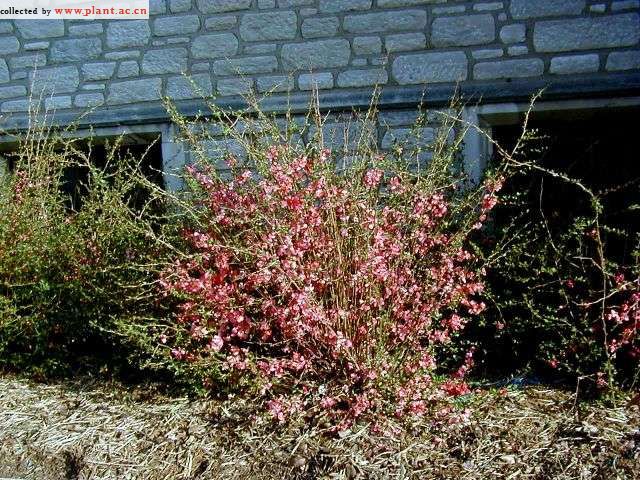Chaenomeles speciosaFlowering quince
科:蔷薇科
Family:Rosaceae
属:木瓜属
common name:Flowering quince
introduce:Plant Type: Deciduous shrub
Family: Rosaceae
Missouri Native: No
Native Range: China
Height: 6 to 10 feet
Spread: 6 to 10 feet
Bloom Time: March - April
Bloom Color: Scarlet to red
Sun: Full sun to part shade
Water: Medium moisture
Maintenance: Low
General Culture:
Easily grown in average, medium moisture, well-drained soil in full sun to part shade. Best flowering occurs in full sun. Adapts to a wide range of soil conditions, but prefers well-drained loams. Established plants will tolerate dryish soils. Plants bloom on old growth. Avoid heavy pruning. Prune to shape as needed in spring after flowering to stimulate growth of flowering spurs which will improve bloom for the following year (although such pruning will reduce fruit production for the current year). Promptly remove root suckers to control possible spread.
Noteworthy Characteristics:
Flowering quince is a dense, broad-rounded, deciduous shrub with often-tangled, spiny, gray-brown twigs. It typically grows to 6-10?tall and as wide. Scarlet to red (less frequently pink or white) five-petaled flowers (to 2?diameter) bloom before the leaves fully unfold in an often showy early spring bloom. Some flowers may be double. Flowers are followed by hard, dot-speckled, yellowish-green fruits (2.5?quinces) that may acquire red tinges as they mature in autumn. Quinces are edible, but usually are considered too bitter to be eaten directly from the shrub. Quinces are sometimes used in preserves and jellies. Finely-toothed, oval to oblong, glossy dark green leaves (to 3.5?long). Leaves may emerge in spring with a bronzy cast. No fall color.
Susceptible to fungal leaf spot (particularly in years with heavy spring rainfall) which can cause considerable leaf defoliation. Fireblight and scab can be problems in some areas. Aphids can cause significant damage to new growth. Lesser pests include scale and mites. Chlorosis (yellowing of foliage) will occur in high pH soils. Flower buds are susceptible to significant damage from early spring frosts.
Uses:
Hedge, screen, barrier. Specimen or group in shrub border or cottage garden. Branches may be clipped and forced for winter bloom.
